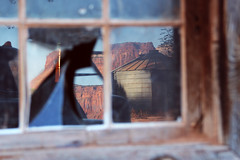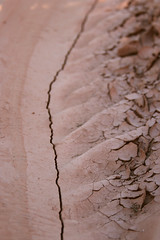Photo of the Day, November 8
Via Flickr:
The view from the groover at our camp site in the Virgin Mountains of Nevada. Don’t know what a groover is? Ask a river runner. Photo by Ysa Diaz.
Photo of the Day, November 7
Via Flickr:
A Rock Wren photographed on a hike in the Virgin Mountains with author Craig Childs. Photo by Erik Lyon
Sonoran Institute
Tomás Rivas, Guadalupe Fonseca, Edith Serrano, Alfredo Tolento, Aurelio Rodríguez, David Rodríguez, Bernbe Rico
Delta Team, Sonoran Institute
Sonora, Mexico (near Mexicali)
October 30 – November 2
The Westies spent the last week learning about the Colorado River Delta in Mexico with employees from the Sonoran Institute’s Delta Legacy Program. The Sonoran Institute in the Delta region is an organization focused on reconnecting the Colorado River with the Sea of Cortez, as well as conservation and restoration in the Delta. They are also working to reconnect the local community with the river. During tours of the Morelo dam and the local wastewater treatment plant the Westies learned that the Colorado river essentially ends on the US – Mexico border. Farther South, the Rio Hardy joins the remaining dribble of the Colorado; a river fed by agricultural runoff and effluent from the wastewater treatment plant. Ironically, our camp had prime waterfront property along the Rio Hardy. Our projects with the Sonoran institute included tree planting, a walking and canoeing tour of the Cienega Santa Clara, and sign assembly for an interpretive walk at the Institute’s Eco Camp. The Delta is also a stop along the Pacific flyway, resulting in fantastic bird watching during our entire stay. The Sonoran Institute was incredibly gracious with their time and energy, providing an experience (including delicious Mexican food!) that was thoroughly enjoyed by all.
For more information visit: http://www.sonoraninstitute.org
By Molly Hayes
Beatríz Grijalva
Beatríz Saavedra Grijalva
Visitor Coordinator for the Cerro Prieto Geothermal Plant
Baja California, Mexico
November 2
Beatriz met us at the Visitor Center of the Cerro Prieto Geothermal Plant, the second largest geothermal power plant in the world. Speaking in English, or through Kate Greenberg, our resident translator, when necessary, she explained the detailed workings of the power plant. Four separate generator stations combine to create 570 MW of generating capacity, saving 10 million barrels of oil from combustion. Cerro Prieto, along with a few other geothermal production facilities, accounts for almost 40% of Baja California’s energy production. On top of electricity production, the plant’s cooling ponds also provide crucial desert habitat for migratory birds and the endangered Desert Pupfish. We appreciate Beatriz’s patience and thoroughness in answering our many questions.
By Collin Smith
Colin Soto
Collin Soto
Cocopah Tribe
Sonora, Mexico
October 30
Collin Soto wears his black hair long in a ponytail that trails down his back. And, like most of the things about Collin Soto, this means something. “I cut my hair when I lose somebody close to me,” he says, “I follow the ways that my people formed over 1,000 years ago.” Collin, a representative of the native Cocopah people of the Southwest, spent a hot October morning in Sonora Mexico talking to us about the challenges faced by a native culture entirely dependent on the water of the Colorado River Delta. This water has, in the past 50 years, dried up after a surge of dam building hit the Colorado River, thereby displacing their entire culture. “We lived off the river,” he said, “totally off the river. You call it environmental studies, we call it a way of life.” When Collin speaks, he looks at each of us, individually, as if to make sure that we are all listening. “We need this to change,” he goes on, “We need to worry about everybody not just ourselves,” he says. With the help of organizations like the Sonoran Institute, the Cocopah people are working to bring water back to the delta—hope back to the shores of a riverbed that has all but dried up.
By Cathryn Klusmeier
James Griffin, Benjamin Camino, y Fernando Fausto Lomcli

James Griffin, Benjamin Camino, y Fernando Fausto Lomcli, a photo by Semester in the West on Flickr.
James Griffin, Benjamin Camino, y Fernando Fausto Lomcli
Historians
Campo Mosqueda, Baja California, Mexico
October 30, 2012
The Westies met with James, Benjamin, and Fernando at a conference center near their camp on the shores of the Hardy River. Having just arrived in the Colorado River Delta region, the historians briefed the Westies on the full history of the Delta. The three covered the past Delta’s past, beginning with the movement into the region by the Cocopah indians and continued on to issues in the Delta up until present time. They discussed the complexity of the historical reasons for the Colorado river no longer flowing into the Gulf of California. All three men highlight the area’s agricultural practices, the impact of the U.S. dams, and the current problem of highly saline water being dumped into Mexico. This segment in the Delta marks the Westies’ last contact with the Colorado river after a month and a half of following it through the Southwest.
By Oliver Wood
Kate Greenberg
Kate Greenberg
Sonoran Institute, former Westie and Field Manager
Colorado River Delta, Mexico
October 29 – November 3
2006 Westie and 2010 Field Manager Kate Greenberg joined the group for our segment in the Colorado River Delta. Kate spent four months in 2011 in the Delta working for the Sonoran Institute, the organization that hosted us in Mexico. The Sonoran Institute works to preserve the culture of the Delta and conserve its character through restoration projects. Using her proficient Spanish and local knowledge, Kate helped us navigate the area and translated the presentations of many of our different speakers including native Cucupah women, a waste water treatment plant manager, and a geothermal plant tour guide. The context she provided made her a key link between the Sonoran Institute staff, our guest speakers, and the Westies. The Westies left Mexico appreciative of all Kate did to plan the segment and making it an eye-opening look at the Delta.
By Allison Bolgiano







